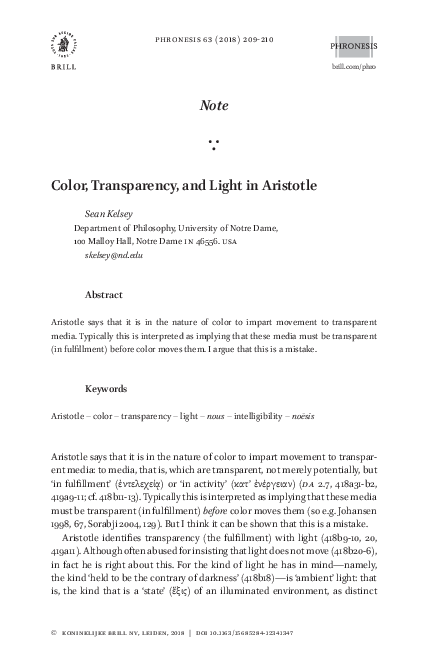Academia.edu no longer supports Internet Explorer.
To browse Academia.edu and the wider internet faster and more securely, please take a few seconds to upgrade your browser.
Color, Transparency, and Light in Aristotle
Color, Transparency, and Light in Aristotle
2018, Phronesis
Aristotle says that it is in the nature of color to impart movement to transparent media. Typically this is interpreted as implying that these media must be transparent (in fulfillment) before color moves them. I argue that this is a mistake.
Related Papers
"The Parva Naturalia in Greek, Arabic and Latin Aristotelianism", ed. B. Byden and F. Radovic
Aristotle’s Transparency: Comments on Katerina Ierodiakonou, “Aristotle and Alexander of Aphrodisias on Colour”2018 •
2018 •
The Parva Naturalia in Greek, Arabic and Latin Aristotelianism. Supplementing the Science of the Soul
Aristotle and Alexander of Aphrodisias on colour2018 •
Rivista di Estetica
Color and transparency2010 •
In this paper I argue that all transparent objects are colorless. This thesis is important for at least three reasons. First, if transparent objects are colorless, there is no need to distinguish between colors which characterize three-dimensional bodies, like transparent colors, and colors which lie on the surface of objects. Second, traditional objections against color physicalism relying on transparent colors are rendered moot. Finally, an improved understanding of the relations between colors, light and transparency is provided.
Discusses paraphrases and intertextuality in Leonardo's writings and Pseudo-Aristotle's De coloribus
RELATED PAPERS
Initium: Revista catalana d'historia del dret
Avvocatura in Italia dal Medioevo all'Età Moderna2015 •
LA HISTORIA OLVIDADA: FILIPINAS-MEXICO 2024
The Domestication of Asia Trans-Pacific Art Objects in 17th Century New Spain2024 •
مجلة العلوم الاقتصادية والادارية
تاثير استقرارية بعض الانشطة السلعية في العراق على تقدير نماذج البيانات المقطعية للفترة (1988-2000)2012 •
Ç. Maner (ed.) Crossroads - Kavşaklar. The Plain of Konya from Prehistory to the Byzantine Period. İstanbul: Ege Yayınları, p. 71-81
(2019b) Silver, Markets and Long-Distance Trade in the Konya Region, 2400-1700 bce. Pp. 72-82 in Crossroads - Kavşaklar. The Plain of Konya from Prehistory to the Byzantine Period, ed. Ç. Maner. İstanbul: Ege Yayınları.2019 •
El Ruha 6th International Conference on Social Sciences
İbnü’l-Arabî’de İnsan-ı Kâmilin Eğitsel ve Siyasal İşlevi2020 •
2015 •
Nanoscale advances
Behavior of α, β tubulin in DMSO-containing electrolytes2019 •
Computers, Materials & Continua
Frilled Lizard Optimization: A Novel Bio-Inspired Optimizer for Solving Engineering Applications2024 •
2011 •
The Lancet Oncology
Characterisation of retinoblastomas without RB1 mutations: genomic, gene expression, and clinical studies2013 •
1994 •

 Sean Kelsey
Sean Kelsey